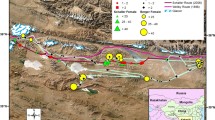Abstract
Human-environment interactions can affect the sex ratios of resource-dependent societies in a variety of ways. Historical and contemporary data on Alaska Native populations illustrate such effects. Some eighteenth and early nineteenth century observers noted an excess of females, which they attributed to high mortality among hunters. Population counts in the later nineteenth century and well into the twentieth found instead an excess of men in many communities. Female infanticide was credited as the explanation: since family survival depended upon hunting success, males were more valued. Although infanticide explanations for the excess of males have been widely believed, available demographic data point to something else: higher adult female mortality. Finally, in the postwar years, the importance of mortality differentials seems to have faded- and also changed direction. Female outmigration from villages accounts for much of the gender imbalance among Native populations today. Natural-resource development, particularly North Slope oil, indirectly drives this migration. In Alaska's transcultural communities, the present gender imbalances raise issues of individual and cultural survival.
Similar content being viewed by others
References
Burch, Ernest S. Jr. (1984). Kotzebue Sound Eskimo. In David Damas (Ed.).Handbook of North American Indians: Volume 5, Arctic, pp. 303–319. Washington DC: Smithsonian Institution.
Chance, Norman A. (1990).The Inupiat and Arctic Alaska: An ethnography of development. Fort Worth: Holt, Rinehart and Winston.
Condon, Richard G. (1987).Inuit Youth: Growth and change in the Canadian Arctic. New Brunswick: Rutgers University Press.
Damas, David (Ed.). (1984).Handbook of North American Indians: Volume 5, Arctic. Washington DC: Smithsonian Institution.
Duffy, R. Q. (1988).The Road to Nunavut: The progress of the Eastern Arctic Inuit since the Second World War. Montreal: McGill-Queen's University Press.
Fienup-Riordan, Ann. (1990).Eskimo essays: Yup'ik Lives and how we see them. New Brunswick: Rutgers University Press.
Flanders, Nicholas E. (1987). Tuberculosis in Western Alaska, 1900–50.Polar Record 23(145), 383–396.
Hamilton, Lawrence C. & Seyfrit, Carole L. (1993a). Town-village contrasts in Alaskan youth aspirations.Arctic 46(3), 255–263.
Hamilton, Lawrence C. & Seyfrit, Carole L. (1993b). Female flight? Gender balance and outmigration by Native Alaskan villagers. Paper presented at the IX International Congress on Circumpolar Health, Reykjavik, Iceland.
Hamilton, Lawrence C. & Seyfrit, Carole L. (1994a). Resources and hopes in Newfoundland.Society and Natural Resources 7(6),561–578.
Hamilton, Lawrence C. & Seyfrit, Carole L. (1994b). Coming out of the country: Community size and gender balance among Alaskan Natives.Arctic Anthropology 31 (1),16–25.
Hamilton, Lawrence C., Rasmussen, Rasmus Ole, Flanders, Nicholas E. & Seyfrit, Carole L. (1996). Outmigration and gender balance in Greenland.Arctic Anthropology 33(1), 89–97.
Jentoft, Svein. (1993).Dangling lines. The fisheries crisis and the future of coastal communities: The Norwegian experience. St. John's, Newfoundland: Institute of Social and Economic Research, Memorial University of Newfoundland.
Jorgensen, Joseph G. (1990).Oil Age Eskimos. Berkeley: University of California Press.
Kizzia, Tom. (1991).The wake of the unseen object: Among the Native cultures of Bush Alaska. New York: Henry Holt.
Krupnik, Igor. (1993).Arctic adaptations: Native whalers and reindeer herders of Northern Eurasia. Hanover, NH: University Press of New England.
Lantis, Margaret. (1984). Aleut. In David Damas (Ed.).Handbook of North American Indians: Volume 5, Arctic, pp. 161–184. Washington DC: Smithsonian Institution.
Masnick, George S. & Katz, Solomon H. (1976). Adaptive childbearing in a North Slope Eskimo community.Human Biology 48(1),37–58.
Messenger, John C. (1969).Inis Beag, Isle of Ireland. New York: Holt, Rinehart and Winston.
Middaugh, John P., Miller, Jack, Dunaway, C. Eitel, Jenkerson, Sue Anne, Kelly, Tom, Ingle, Diane, Perham, Kathy, Fridley, Duane, Hlady, W. Gary & Hendrickson, Valerie (1991).Causes of death in Alaska 1950, 1980–1989. Anchorage: Alaska Department of Health and Social Services.
Milan, Frederick A. (1964). The acculturation of the contemporary Eskimos of Wainwright, Alaska.Anthropological Papers of the University of Alaska 11(2),1–95.
Oswalt, W. H. (1990).Bashful no longer: An Alaskan Eskimo ethnohistory, 1778–1988. Norman: University of Oklahoma Press.
Scheper-Hughes, Nancy. (1979).Saints, scholars, and schizophrenics: Mental illness in rural Ireland. Berkeley: University of California Press.
Seyfrit, Carole L. & Hamilton, Lawrence C. (1992a). Who will leave? Oil, migration, and Scottish island youth.Society and Natural Resources 5(3),263–276.
Seyfrit, Carole L. & Hamilton, Lawrence C. (1992b). Social impacts of resource development on Arctic adolescents.Arctic Research of the United States 6(Fall),57–61.
Taylor, Kenneth I. (1966). A demographic study of Karluk, Kodiak Island, Alaska, 1962–1964.Arctic Anthropology 3(2),211–239.
Tuljapurkar, Shripad, Li, Nan & Feldman, Marcus W. (1995). High sex ratios in China's future.Science 267, 874–876.
Author information
Authors and Affiliations
Rights and permissions
About this article
Cite this article
Hamilton, L.C., Seyfrit, C.L. & Bellinger, C. Environment and sex ratios among Alaska Natives: An historical perspective. Popul Environ 18, 283–299 (1997). https://doi.org/10.1007/BF02208424
Issue Date:
DOI: https://doi.org/10.1007/BF02208424




